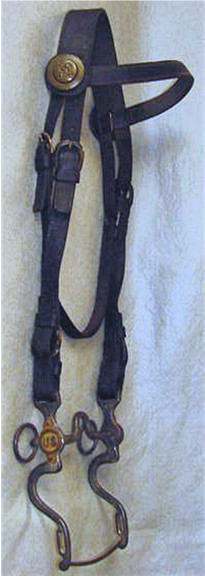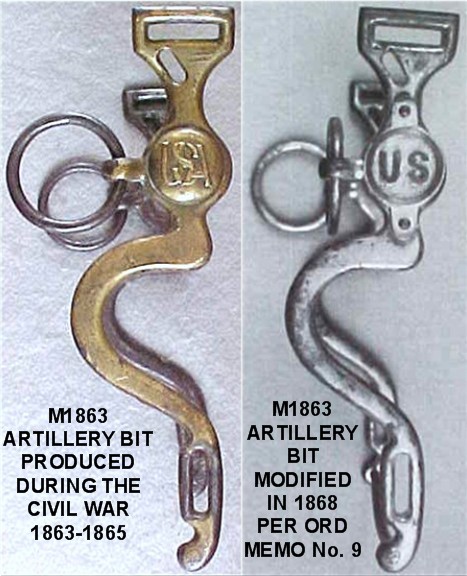|
CIVIL WAR ARTILLERY BRIDLE WITH MODEL 1863
ARTILLERY BIT – VERY NICE SET COMPLETE WITH THE “USA”
BRASS BRIDLE ROSETTES: This Civil War era US
Army Artillery Bridle Set spans a long period of
history, and like so many military collectibles, the
devil is in the details. 
This headstall is fitted with brass horseshoe-shaped
buckles and the brass crown ornaments featuring the
intertwined “USA”. The 1850 Ordnance Manual described
the artillery bridle as being fitted with wrought iron
buckles with a black japanned finish and makes no
mention of the brass crown ornaments of any kind. A
second edition of that manual with an inscription dated
1858 retains this same description. The 1862 Ordnance
Manual is where the first mention is found of the brass
crown ornaments, and the description of the bridle
includes cast brass buckles “with rollers”.
The presence of the brass crown ornaments and the brass
buckles date this headstall as having been manufactured
during the Civil War. That the buckles are
horseshoe-shaped and are not fitted with rollers is not
particularly surprising given that much of the equipment
produced during the war was manufactured by civilian
contractors and variations in their work is well
documented.
This headstall is complete with the crown piece, both
crown ornaments, brow band, both cheek pieces and the
throat lash. The crown piece ends in two billets on
both sides – one billet is for the cheek piece that
attaches to the bit and the other billet is for the
throat latch that passes under the horse’s jaw. All of
the billets are full length – notable as these were
often shortened by the soldier to eliminate excess
leather once the bridle had been fitted to his horse.
The leather surfaces are overall smooth with a stable
finish. The leather is supple and pliable, there are no
weak points, and all of the matching brass
horseshoe-shaped buckles are present. The brass crown
ornaments are full form and have a very attractive aged
patina.
There is a prevailing misunderstanding as to the
identity of the original Model 1863 Artillery Curb Bit
as it presented during the Civil War, and the
modifications to the bit that were ordered after the war
– both shown in the photograph immediately below. The
Model 1863 Artillery Curb Bit was originally produced as
a brass faced bit with the dome shaped, brass shell lead
filled decorative bosses bearing the intertwined USA.
The brass facing, a holdover from the earlier Dragoon
Period, did not survive well in service and as the
underlying iron began to corrode, the thin brass
sheeting would break away. After the war, the army
having long recognized corrosion as a significant
problem, had the time and resources to seek out a
solution and they began experimenting with plating –
both tin and nickel – on firearms, bits, and a number
of fittings associated with horse equipment.
As a result of the 1868 Ordnance Board, the following
order regarding bits was issued as part of Ordnance
Memoranda No. 9:
“TINNING ARTILLERY AND CAVALRY BITS – The Board
recommend (sic) that all new artillery and cavalry bits
should be tinned, and that all old bits requiring
repairs or cleaning should likewise be tinned, instead
of bluing or replating.”
In the process of refurbishing the Model 1863 Artillery
Bits then in service, the decorative “USA” bosses had to
be removed. The thin brass shell likely did not survive
being removed in a condition that would be acceptable to
be reattached. The more substantial cast brass “US”
bosses in use on cavalry bits were far more durable,
were much easier to attach, and were available in
quantity, so as the artillery bits were refurbished, or
new bits were produced, the cast “US” bosses replaced
the “USA” domed shells. This process yielded the bit
shown on the right in the photograph below – compared to
the Model 1863 Artillery Bit in its original form shown
on the left.
The experimentation with plating yielded limited
positive results, and the army’s dissatisfaction
resulted in the effort being soon abandoned. As a
result of the short period in which the bits were tin
plated, few plated specimens of these modified Model
1863 Artillery Bits survive today.

This bridle is complete with a Model 1863 Artillery Curb
Bit showing the modifications authorized in 1868,
indicating it was used by the post-Civil War Frontier
Army. As with so much of the Civil War cavalry and
artillery equipment, these bridles were used well into
the 1880’s by mounted soldiers on the Western Frontier
in spite of the adoption of the Model 1874 Bridle for
all horses.
The bit is full form with both brass bosses, both rein
rings, and the lower bar all present and intact. The
inside of the off-side or right hand cheek piece and the
near-side or left hand end of the mouthpiece are both
stamped “US”. These stamps are a nice added value as
not all of these bits were so stamped. This bit has not
been abused nor has it suffered from age or poor
storage, with no damage or bending out of its original
shape. This bit has retained much of the tin plating
and where it was worn away through use, the exposed
steel is very clean with no pitting to the
surfaces.
These Civil War Model 1863 Artillery Headstalls and Bits
have never been common, and
are prized today as one of the most attractive bridle
sets ever issued by the U.S. Army. Francis Bannerman
and other military surplus dealers listed these sets as
Civil War officers’ equipment and many collectors
continue to cherish this belief. While it is certain
that officers from all branches of the army obtained
these headstalls and bits for their own use, these
distinctive robust sets were designed for the teams of
heavy horses that delivered the field pieces to the
battlefields. This is a very nice set which spans both
the Civil and Indian Wars and it is one that would never
need to be upgraded once on display in your collection.
SOLD
|

